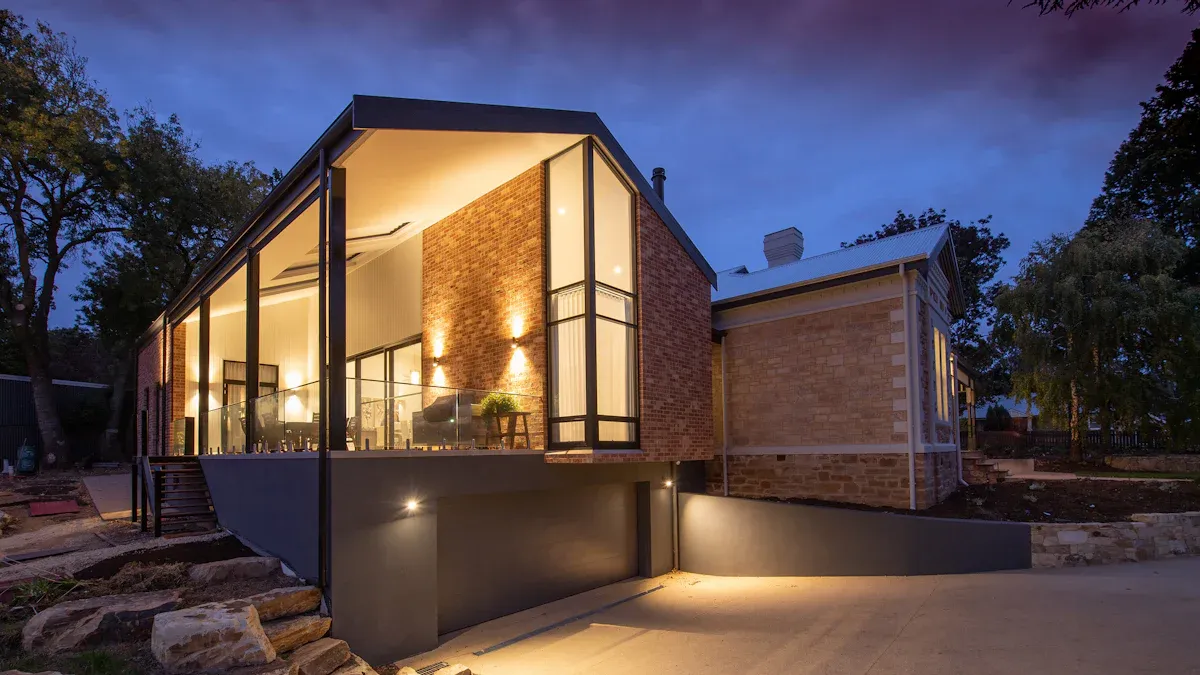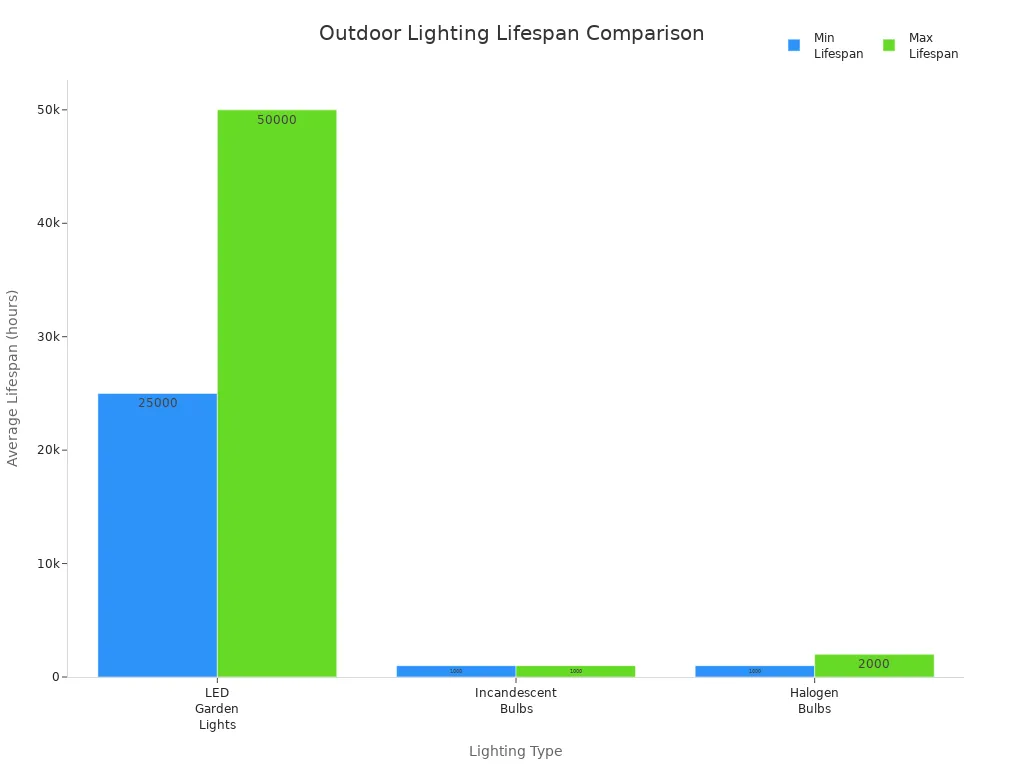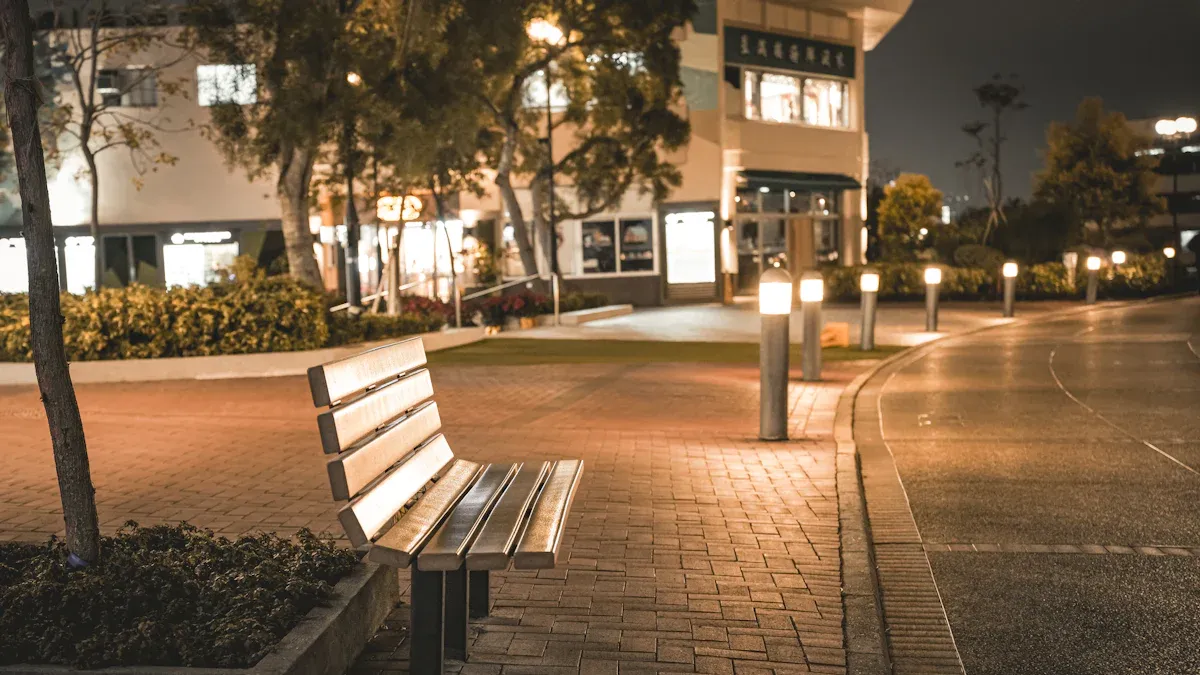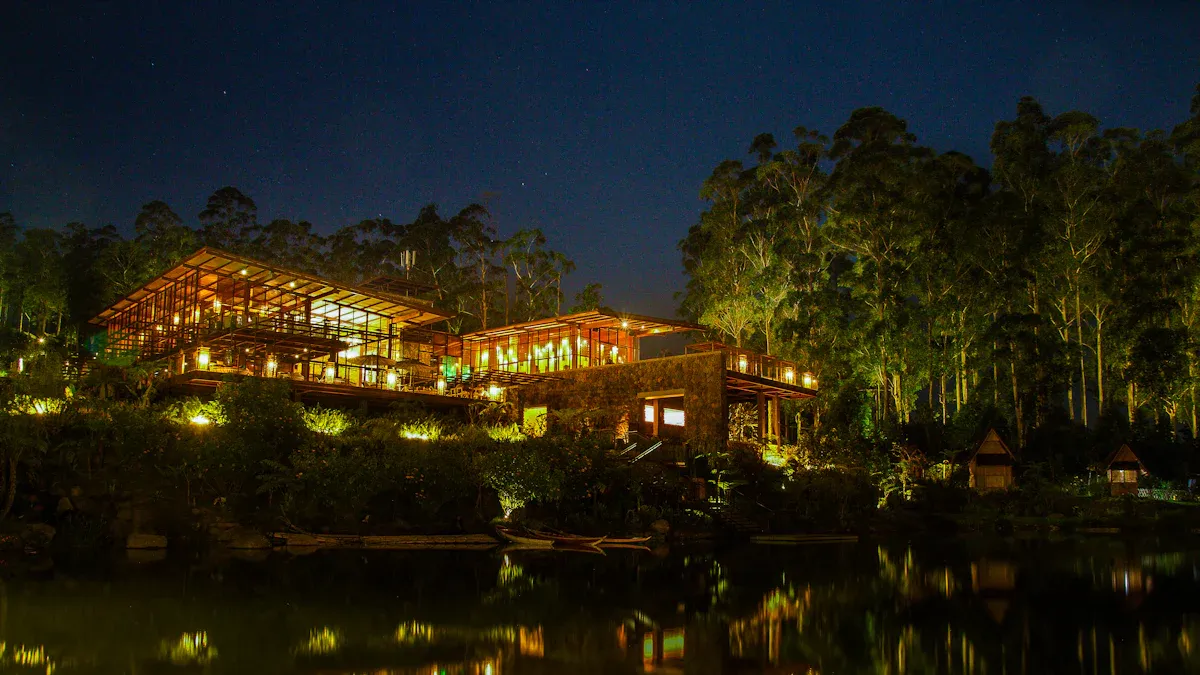Outdoor LED Lamps for Energy-Efficient Landscape Lighting

Are outdoor LED lamps the best for saving energy outside? Yes, they are! Outdoor LED lights use much less energy than old bulbs. You can save money and help the earth at the same time. If you want to change your yard, LED landscape lighting is a great choice. These lights last a long time and are strong in bad weather. You get green lighting that is simple to put in and good for any homeowner. Outdoor LED canopy lights and outdoor LED lamps can fit any yard. You can make paths bright or add cool touches with LED outdoor lighting. LED lights can really change your outdoor space.
Durability: LED bulbs can take bumps, shakes, and bad weather.
Eco-friendliness: LEDs last longer, have no mercury, and make less trash.
Versatility: Use LED canopy lights, spotlights, or string lights for fun outdoor lighting.
Check out our Home, About Us, and Product pages to find the right Led Light for your yard.
Key Takeaways
Outdoor LED lamps save up to 70% energy compared to old bulbs, lowering your electric bills and helping the environment.
LED lights last much longer—up to 50,000 hours—so you change bulbs less often and reduce waste.
These lamps are tough and weatherproof, working well in rain, snow, heat, and cold without breaking.
You can choose from many LED light types like pathway, flood, spotlight, and underwater lights to fit your yard’s needs.
Smart controls and solar options make LED lighting easy to install, use, and save even more energy.
Why Outdoor LED Lamps
Energy Efficiency
If you want to save energy outside, outdoor led lamps are the best pick. These lights use much less energy than old bulbs. You still get bright light but pay less for electricity. Outdoor led lights can give you 40 to 80 lumens for each watt. This is more than other types of lights. You can use dimmable led bulbs or motion sensors to save even more energy.
Here’s a simple table showing how outdoor led lamps compare to other lights:
Aspect | Outdoor LED Lamps | High-Pressure Sodium (HPS) Lamps |
|---|---|---|
Energy Efficiency | Use up to 70% less energy than HPS; same or better brightness | Use lots of energy; higher electricity bills |
Heat Management | Make little heat; safer and cheaper to cool; work well in hot or cold | Make lots of heat; cost more to cool; don’t last as long |
Lifespan | Last over 50,000 hours; fade slowly so you know when to change | Last about 24,000 hours; get dim and need changing more often |
Light Quality | Show colors well; look like daylight; shine light where you want | Colors look strange; yellow-orange glow; hard to see true colors |
Cost (Long-Term) | Cost more at first but save money later; need less fixing | Cheaper at first but cost more to run and fix |
Environmental Impact | Better for the earth; can be recycled; no bad stuff like mercury | Worse for the earth; make more pollution; not as green |
Outdoor led lights may cost more when you buy them. But you save money because they use less power and last longer. If you switch to led lights, you can cut your yearly cost by about 75%. In ten years, you could save over $1,000. You also need less wiring and a smaller transformer, so it is easier and cheaper to set up.
Outdoor led lights give more light but use less power.
You can add more lights without needing a bigger transformer.
Led bulbs last up to 50,000 hours, so you change them less.
If you want to save energy and make your yard look nice, led lights are the best choice. They help you spend less and make your landscape look great.
Durability and Weather Resistance
Outdoor led lamps are made to last a long time. They can handle rain, snow, heat, and cold. These lights use strong metals and weatherproof plastics. You don’t have to worry about them breaking in bad weather.
Here’s a table showing how long different outdoor lights last:
Lighting Type | Average Lifespan (hours) | Typical Years of Use (based on usage) | Notes on Durability and Factors Affecting Lifespan |
|---|---|---|---|
LED Garden Lights | 10 - 20 years | Slowly get dimmer; depends on quality and environment | |
Incandescent Bulbs | 1,000 | 1 - 2 years | Burn out fast; not good for outdoors |
Halogen Bulbs | 1,000 - 2,000 | 1 - 3 years | Not as good; don’t last as long as LEDs |

You can see outdoor led lights last much longer than other lights. They don’t burn out quickly. Instead, they slowly get dimmer over many years. Most led lights work for 10 to 20 years, even if you use them every night. You spend less time changing bulbs and make less trash.
Outdoor led lamps need less fixing. They don’t get as hot, so bugs don’t come as much. You just check the wires and clean the lights sometimes. If you use solar led lights, you get even more good things. Solar lights use the sun, so you don’t need wires or worry about power going out.
Here are more reasons why outdoor led lights are good for the earth:
Environmental Benefit | Explanation |
|---|---|
LED lamps have no mercury, unlike other lamps that need special care to avoid pollution. | |
Lower Maintenance | LEDs last much longer, so you change them less. This means less waste and less work. You also save money on repairs. |
Recyclability | LED lights can be recycled easily. You don’t need special places to recycle them. |
Additional Benefits | LEDs save energy, don’t make UV rays, are strong, safe, make less heat, and help the earth. |
Tip: If you want your yard to be even greener, try solar outdoor led lights. They use the sun and work well in most places.
With all these good things, outdoor led lamps are a smart pick for anyone who wants strong, energy-saving lights for their yard. You get tough, long-lasting lights that save money and help the planet.
Types of Outdoor LED Lights

When you want to light up your yard, you have lots of choices. Each type of outdoor led light has a special job. Let’s look at the best type of led light for outdoor use and see how you can use them in your landscape.
Pathway Lights
Pathway lights help you see where you are walking at night. You can use led path lights along sidewalks, driveways, and garden paths. These lights make your yard safer and add a warm glow. Most pathway lighting uses low voltage, like 12V or 24V, so you save energy. Led path lights use about 1.5 to 3 watts but give you 100 to 200 lumens. That’s bright enough to see but not too harsh. Many pathway lights have IP65 waterproof ratings, so rain and dust won’t hurt them.
Tip: Try solar-powered led lights for your pathway. They charge during the day and turn on by themselves at night.
Flood Lights
Flood lights give you a lot of light over a big area. You can use led flood lights to brighten your backyard, driveway, or even a sports area. These outdoor led lights use about 9 to 18 watts and can shine 700 to 20,000 lumens. They are perfect for security and safety. Most flood lights are weather-resistant and have IP65 ratings, so they last through storms.
Spotlights
Spotlights let you show off your favorite tree, statue, or garden feature. Led spotlights have a narrow beam, so you can point them right where you want. They use 500 to 1,200 lumens and save up to 90% more energy than old bulbs. You can use spotlights to make cool shadows and highlights in your landscape.
Deck and Step Lights
You can use led step and deck lights to make stairs and decks safer. These outdoor led lights are small but bright, using only 20 to 100 lumens. They fit on steps, deck posts, or under railings. They don’t get hot, so they are safe to touch. Many people use solar deck lights to save even more energy.
String and Bollard Lights
String lights add a fun, cozy feeling to patios and gardens. You can hang them across your porch or between trees. Bollard lights stand tall along pathways or open spaces. Both types use outdoor led lights that are weatherproof and energy-saving. String lights use 10 to 400 lumens, while bollard lights can go up to 1,000 lumens.
Underwater Lights
Underwater lights make ponds, fountains, and pools look amazing at night. These outdoor led lights are waterproof and safe for water use. You can pick colors to make your water features stand out. Underwater lights use 100 to 2,000 lumens and have strong IP65 or higher ratings to keep water out.
Here’s a quick table to help you compare:
Light Type | Typical Lumens | Wattage | Best Use | Special Feature |
|---|---|---|---|---|
Pathway Lights | 100-200 | 1.5-3W | Walkways, driveways, gardens | Low voltage, IP65 |
Flood Lights | 700-20,000 | 9-18W | Yards, security, large areas | Wide beam, IP65 |
Spotlights | 500-1,200 | 5-10W | Trees, statues, accents | Narrow beam, IP65 |
Deck/Step Lights | 20-100 | 1-3W | Steps, decks, railings | Low heat, solar option |
String/Bollard | 10-1,000 | 1-10W | Patios, paths, open spaces | Decorative, IP65 |
Underwater Lights | 100-2,000 | 5-20W | Ponds, fountains, pools | Waterproof, color RGB |
With so many choices, you can find the right outdoor led lights for every part of your landscape. Pick the ones that fit your style and needs, and enjoy a bright, safe, and energy-saving yard!
Benefits of LED Landscape Lighting

Lower Energy Costs
You can save a lot of money when you switch to outdoor led lights. These lights use up to 80% less energy than old incandescent or halogen bulbs. That means your electric bill goes down every month. Outdoor led lights also work with timers, motion sensors, and smart controls. You only use light when you need it, so you never waste energy. The durability of outdoor led lights means you spend less on repairs and replacements, too.
Outdoor led lights use less electricity and give you more light.
You can set up smart features to control when your lights turn on and off.
Lower energy use means you help the planet and your wallet.
Long Lifespan
Outdoor led lights last much longer than other types of lighting. You might get up to 50,000 hours of use from one led bulb. That’s over 15 years if you use them every night! Take a look at this table:
Lighting Technology | Typical Lifespan (hours) | Approximate Years of Use |
|---|---|---|
LED | ~50,000 | 15+ years |
Halogen | ~1,000 | 1-3 years |
Incandescent | Up to 3,000 | 1-2 years |
You won’t have to climb ladders or dig up fixtures to change bulbs all the time. Outdoor led lights keep your landscape bright year after year, even in tough weather.
Eco-Friendly Design
You help the environment when you choose led landscape lighting. Outdoor led lights use low-voltage systems, so they need less power. They also last longer, which means less waste in landfills. LEDs turn most of their energy into light, not heat, so they don’t waste power. The solid build of outdoor led lights means they don’t break easily, so you throw away fewer bulbs. You can also pick shielded fixtures and warm color temperatures to protect wildlife and keep your yard peaceful.
Tip: Use timers and motion sensors to make sure your outdoor led lights only run when needed. This saves even more energy and keeps your landscape eco-friendly.
Versatile Applications
You can use outdoor led lights almost anywhere in your landscape. Light up pathways, gardens, decks, and even water features. Outdoor led lights work for homes, businesses, parks, and resorts. You can pick from many styles, like color-changing lights, classic white, or smart Wi-Fi controls. Outdoor led lights make your space safer, more beautiful, and more useful after dark. They also help keep your property secure by lighting up dark spots.
Outdoor led lights improve safety on walkways and steps.
You can highlight trees, statues, or water features.
Smart controls let you change your lighting for any event or mood.
The benefits of outdoor led lights go beyond just saving money. You get a long-lasting, eco-friendly, and flexible way to light up your landscape.
Choosing Outdoor LED Lamps
When you start buying outdoor led lights, you want to make sure you pick the best ones for your yard. You have a lot of choices, so let’s break down what matters most for landscape lighting design.
Brightness and Wattage
You need to match the brightness and wattage to each area in your yard. If you use too much light, you waste energy and might bother your neighbors. If you use too little, you miss out on safety and style. Here’s a simple table to help you choose the right wattage for different lighting uses:
Lighting Type | LED Wattage Range (Watts) | Typical Lumens | Best Use |
|---|---|---|---|
Pathway & Step Lighting | 100-200 | Pathways, garden borders, steps | |
Security & Flood Lighting | 10 to 50 | 700+ | Large areas, driveways, security zones |
Accent Lighting | 3 to 10 | 200-500 | Trees, statues, garden features |
Entrance Lighting | 40 to 80 (equivalent) | 400-800 | Front doors, gates, main entrances |
You want lower wattage for pathway lights and accent lighting. For big spaces or security, go higher. A 10-watt led bulb can shine as bright as a 60-watt halogen, so you save energy and money. Always check the lumens, not just the watts, to see how bright your lighting will be.
Tip: Think about why you need lighting. Use soft, low-wattage lights for ambiance. Use bright, high-wattage lights for security or tasks.
When you plan your landscape lighting design, ask yourself:
What is the purpose of the lighting? (Safety, style, security)
How big is the area you want to light?
Do you want to highlight features or just light up a path?
Will you need dimming or smart controls?
Color Temperature
Color temperature changes how your yard feels at night. You measure it in Kelvins (K). Warm light (2700K–3000K) makes your space cozy and welcoming. Cool light (4000K–5000K) looks bright and modern, perfect for security or big areas. Matching the color temperature with your home’s exterior lighting keeps everything looking smooth and stylish.
Here’s a quick table to help you pick:
Color Temperature (Kelvin) | Ambiance Effect | Best Use |
|---|---|---|
2700K–3000K | Cozy, relaxing | Gardens, patios, pathway, accent lighting |
3000K–4000K | Balanced, natural | Walkways, decks, entrances |
4000K–5000K | Bright, energetic | Security, driveways, large open areas |
If you want a soft glow for relaxing, go with warm white. For safety and visibility, choose cool white. Try not to mix too many color temperatures, or your lighting might look messy.
Warm white is great for pathway and accent lights.
Cool white works best for security and flood lights.
Neutral white fits walkways and entrances.
Note: Very cool lights (above 5700K) can mess with sleep and wildlife, so stick to 3000K–5000K for most outdoor lighting.
Durability and IP Ratings
You want your outdoor led lamps to last through rain, snow, and dust. That’s where IP ratings come in. IP stands for “Ingress Protection.” The higher the number, the better the protection. For most outdoor lighting, look for IP65 or higher. This keeps your lights safe from water jets and dust.
Environment Type | Recommended IP Rating | Protection Provided |
|---|---|---|
Covered patios, porches | Splash-proof, basic dust protection | |
Open-air gardens, city squares | IP65 | Dust-tight, water jet resistant |
Near pools, fountains | IP67 | Can handle short-term water submersion |
Underwater (ponds, fountains) | IP68 | Full waterproof for underwater use |
You should also check for tough materials like aluminum or stainless steel. These resist rust and damage. Sealed housings and strong glass help keep moisture out. If you live in a place with harsh winters or lots of rain, go for higher IP ratings and impact-resistant designs.
Look for certifications like UL or ETL for safety.
Pick lamps with sealed gaskets and welded end caps for extra durability.
Choose corrosion-resistant finishes for long-lasting style.
Installation and Controls
You want lighting that’s easy to install and control. Many outdoor led lamps come with plug-and-play kits, so you can set them up yourself. Low-voltage systems are safer and simpler for a homeowner. If you need hardwired or high-voltage lighting, you might want a professional to help.
Here are some installation options:
Plug-and-play kits for quick DIY setup.
Solar-powered lights for easy placement and no wiring.
Low-voltage transformers for safe, flexible landscape lighting design.
Battery-powered fixtures for spots without outlets.
Smart controls make your lighting even better. You can use apps, remotes, or voice commands to turn lights on and off, set schedules, or change brightness. Motion sensors help save energy by turning lights on only when needed. Some systems work with WiFi, Bluetooth, or smart home platforms.
Tip: Before you install, draw a simple map of your yard. Mark where you want each light. This helps you plan wiring and placement for the best results.
Easy installation means you spend less time and money. Retrofit kits let you upgrade old lights without new wiring. Smart controls give you more options for saving energy and setting the perfect mood.
If you’re a homeowner looking to upgrade your landscape lighting design, focus on brightness, color temperature, durability, and controls. You’ll get a yard that’s safe, stylish, and energy-efficient.
You can transform your outdoor space with LED landscape lighting. These lights give you brighter, natural-looking light and last much longer than old bulbs. You save money, help the environment, and enjoy a safer, more stylish landscape. Take a look at your current lighting. Try switching to LEDs for better energy savings and less waste. Your landscape will look great in every season!
FAQ
How long do outdoor LED lamps usually last?
You can expect outdoor LED lamps to last up to 50,000 hours. That means you might not need to change them for over 10 years, even if you use them every night.
Are LED lights safe to use in wet weather?
Yes, most outdoor LED lamps have high IP ratings. This means they can handle rain, snow, and even splashes from sprinklers. You do not need to worry about water damage.
Can I install outdoor LED lights by myself?
You can install many outdoor LED lights on your own. Plug-and-play kits and solar options make it easy. For hardwired systems, you might want help from a professional.
What are led canopy lights used for outside?
You can use led canopy lights to brighten patios, porches, or carports. They give wide, even light and work well for both homes and businesses. These lights also save energy and last a long time.
Do LED lights attract bugs at night?
LED lights attract fewer bugs than old bulbs. They do not give off much heat or UV light. Your outdoor space stays more comfortable and bug-free.
See Also
Comparing Energy Savings And Costs Of LED Streetlights
Benefits Of LED Street Bulbs: Longevity And Energy Use
Guide To Outdoor Lamp Models, Features, And Setup Advice

